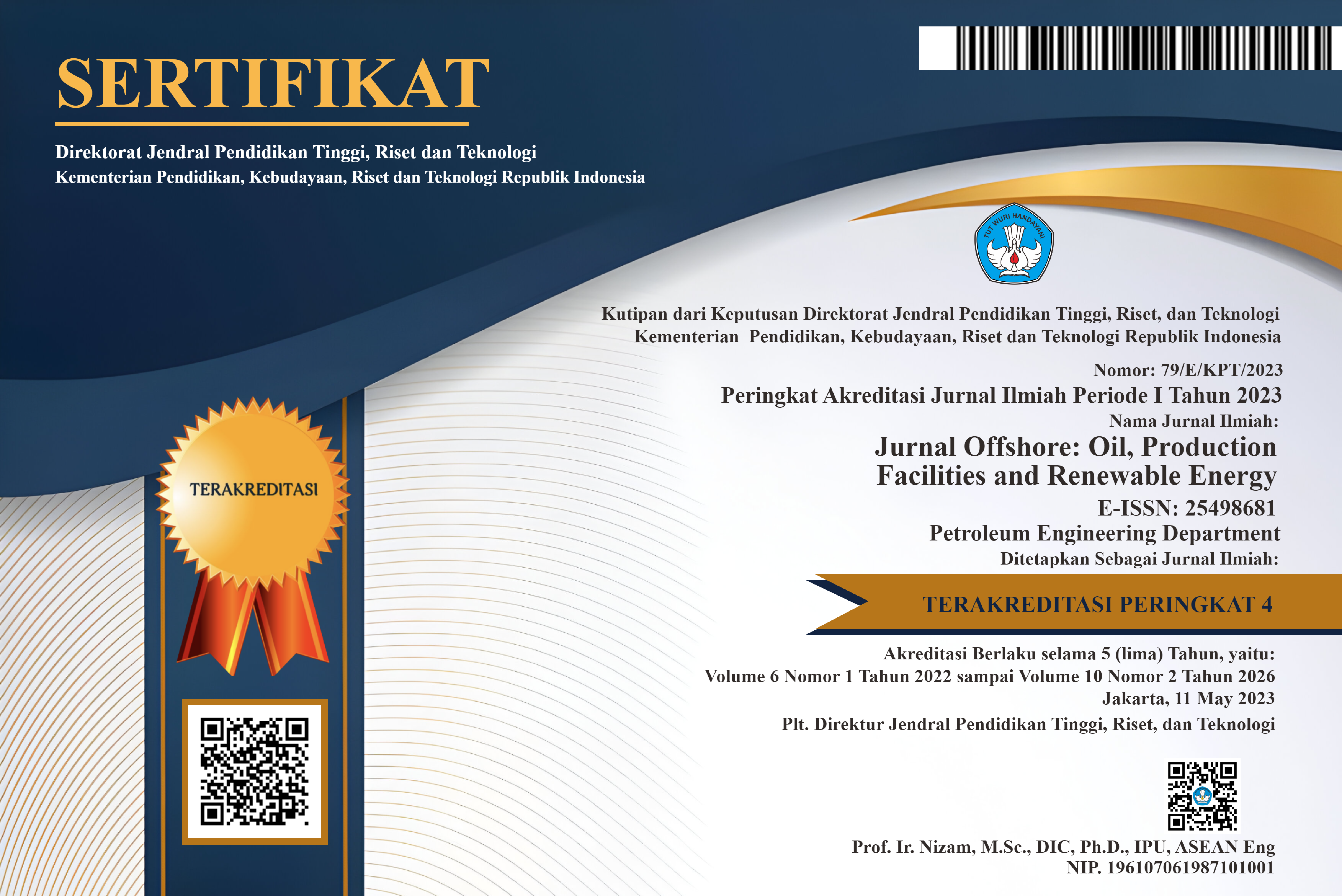Examining the Performance of Palm-Oil-Based Surfactant in Increasing Oil Recovery Through Spontaneous Imbibition Test: A Case Study in Light Crude Oil
DOI:
https://doi.org/10.30588/jo.v6i2.1072Keywords:
EOR, surfactant, recovery, spontaneous imbibition, light oilAbstract
Along with the increasing demand for oil and decreasing production every year, we are faced with the challenge of being able to maximize the potential of our oil resources. The decline in production in Indonesia is largely due to the fact that Indonesia's oil fields which are still operating today are mature fields whose production is already very low. Enhanced Oil Recovery (EOR) is one method that has been proven capable of producing residual oil in a field. One type is Chemical Enhanced Oil Recovery (CEOR) which injects chemicals to increase oil mobility. Surfactants are chemicals that have been widely applied for chemical injection. Its ability to reduce interfacial tension (IFT) and alter rock wettability is the main mechanism of surfactants. In this test, the surfactant used is a palm-based surfactant and will be applied to light oil. Tests such as compatibility test, IFT test, contact angle test, and spontaneous imbibition test were carried out to get a conclusion about the performance of a surfactant. In the compatibility test, the samples in this study all formed a hazy solution at all test concentrations. IFT measurements carried out showed that surfactants were able to achieve an IFT value of 10-3 (ultralow) at a concentration of 0.5%. In addition, based on the contact angle test, samples of surfactant X 0.5% and 0.3% were able to form a smaller contact angle than brine. To measure the performance of surfactant in increasing oil recovery, a spontaneous imbibition test was carried out and the results were that both samples of surfactant X 0.3% and X 0.5% were able to produce recovery factors of 53.5% and 54.2%, which were greater than the recovery factor of brine, which was 43.7%.References
Abdurrahman, M., Permadi, A. K., Bae, W. S., & Masduki, A. (2017). EOR in Indonesia: past, present, and future. International Journal of Oil, Gas and Coal Technology, 16(3), 250-270.
Babadagli, T. (2007). Development of mature oil fields—A review. Journal of Petroleum Science and Engineering, 57(3-4), 221-246.
DEN. 2019. Laporan Kinerja Sekretariat Jenderal Dewan Energi Nasional
Eni, H., Sutriah, K., & Muljani, S. (2017). Surfaktan Berbasis Minyak Sawit Untuk Aplikasi Eor Pada Lapangan Minyak Intermediet (Surfactant based on Palm Oil for EOR Application at Intermediate Oil Field). Lembaran publikasi minyak dan gas bumi, 51(1), 13-21.
Green, D. W., & Willhite, G. P. (1998). Enhanced oil recovery (Vol. 6, pp. 143-154). Richardson, TX: Henry L. Doherty Memorial Fund of AIME, Society of Petroleum Engineers.
Putra, B. P., & Kiono, B. F. T. (2021). Mengenal Enhanced Oil Recovery (EOR) Sebagai Solusi Meningkatkan Produksi Minyak Indonesia. Jurnal Energi Baru dan Terbarukan, 2(2), 84-100.
Sagir, M., Mushtaq, M., Tahir, M. S., Tahir, M. B., & Shaik, A. R. (2020). Surfactants for enhanced oil recovery applications (pp. 65-87). Cham: Springer.
Saxena, N., & Mandal, A. (2021). Natural Surfactants: Application in Enhanced Oil Recovery. Springer International Publishing AG.
Sheng, J. J. (2010). Modern chemical enhanced oil recovery: theory and practice. Gulf Professional Publishing.
Sheng, J. J. (2015). Status of surfactant EOR technology. Petroleum, 1(2), 97-105.
Sugihardjo, S., & Eni, H. (2014). Substitution of petroleum base with mes base surfactant for eor: laboratory screening. Scientific Contributions Oil and Gas, 37(1), 35-44.
Downloads
Published
How to Cite
Issue
Section
License
Authors retain copyright and grant the Jurnal Offshore right of first publication with the work simultaneously licensed under a Creative Commons Attribution 4.0 International License that allows others to share (copy and redistribute the material in any medium or format) and adapt (remix, transform, and build upon the material) the work for any purpose, even commercially with an acknowledgement of the work's authorship and initial publication in Jurnal Offshore. Authors are able to enter into separate, additional contractual arrangements for the non-exclusive distribution of the journal's published version of the work (e.g., post it to an institutional repository or publish it in a book), with an acknowledgement of its initial publication in Jurnal Offshore. Authors are permitted and encouraged to post their work online (e.g., in institutional repositories or on their website) prior to and during the submission process, as it can lead to productive exchanges, as well as earlier and greater citation of published work (See The Effect of Open Access).















